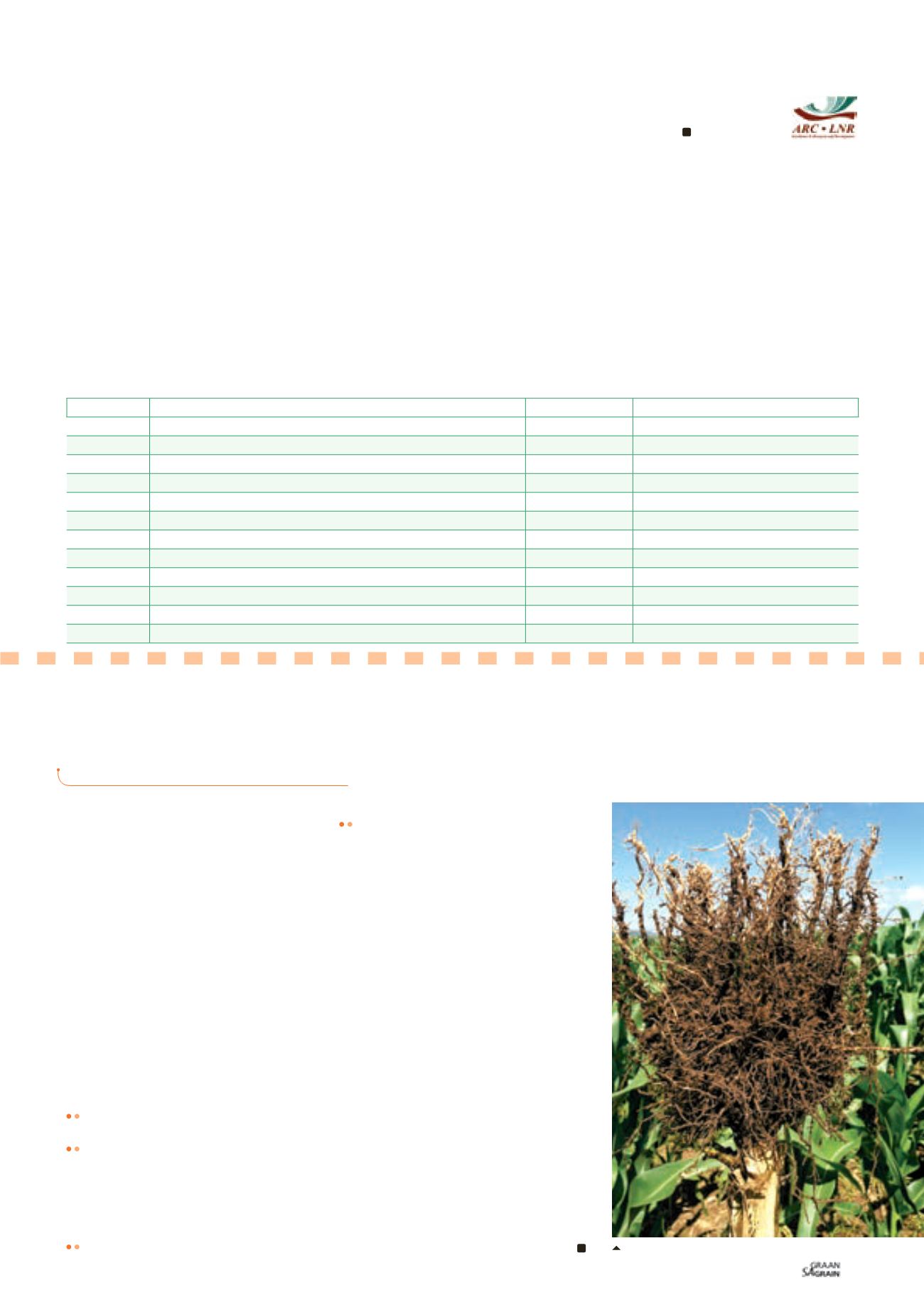

55
NAME
PEDIGREE
SOURCE
STRESS TOLERANCE INDEX
LM02
JIANG 4/4/DUCULA
CIMMYT
0,76
LM04
ONIX/4/MILAN/KAUZ//PRINIA/3/BAV92
CIMMYT
0,86
LM05
ACHTAR/4/MILAN/KAUZ//PRINIA/3/BAV92
CIMMYT
0,89
LM09
SOKOLL*2/ROLF07
CIMMYT
0,84
LM13
SOKOLL/ROLF07
CIMMYT
0,55
LM17
ESDA/KKTS
CIMMYT
0,75
LM21
PRL/2*PASTOR
CIMMYT
0,82
LM22
MUNAL #1
CIMMYT
0,92
LM23
QUAIU
CIMMYT
1,07
LM29
PRL/2*PASTOR*2//SKAUZ/BAV92
CIMMYT
0,98
LM45
ROLF07/YANAC//TACUPETO F2001/BRAMBLING
CIMMYT
0,81
LM85
SW94.60002/4/KAUZ*2//DOVE/BUC/3/KAUZ/5/SW91-12331
CIMMYT
0,91
TABLE 1: LIST OF DROUGHT TOLERANT WHEAT GENOTYPES SELECTED FOR BREEDING AND THEIR STRESS TOLERANCE INDICES.
The materials were evaluated under drought stressed and non-
stressed conditions in two greenhouses and two field experiments
during 2014/2015 and 2015/2016. Water stress was induced from
50% heading to physiological maturity (to mimic terminal drought)
by withholding irrigation to 35% field capacity before re-watering.
A custom-made plastic mulch rain-out shelter system was used
for field evaluation; eliminating the effects of untimely rainfall
(
Photo 1
and
Photo 2
).The initiative is financially supported by the
NRF-Research and Technology Fund.
Brief findings of the study
The study selected twelve genotypes (
Table 1
) with high grain yield
and favourable adaptive traits under drought stressed conditions
useful for breeding. The yield performance of these genotypes
under drought stressed conditions and their stress tolerance
indices were above those of local checks evaluated in the study
(Mwadzingeni
et al
., 2016b).
The selected genetic resources were crossed and progeny tests
were concluded. The selected parents and families of these
crosses will be evaluated and doubled haploid individuals will be
extracted to develop pure line cultivars. These materials will be
available to breeders. The preliminary outcome of this is made avail-
able in the scientific domain (Mwadzingeni
et al
., 2016b).
For more information contact Mr Learnmore Mwadz-
ingeni at
mwadzingenil@ukzn.ac.za .References
Botai, CM, Botai, JO, Dlamini, LC, Zwane, NS, and Phaduli, E. 2016.
Characteristics
of droughts in South Africa: A case study of Free State and North West Provinces
.
Water. 8:439.
Edossa, DC, Woyessa, YE, and Welderufael, WA. 2014.
Analysis of droughts in the
central region of South Africa and their association with SST anomalies
. Interna-
tional Journal of Atmospheric Sciences. 2014: 1 - 8.
Department of Agriculture, Forestry and Fisheries. 2013.
Trend in the Agricultural
Sector
. DAFF, RSA, Pretoria, ISSN 1 025 - 5 028.
Mwadzingeni, L, Shimelis, H, Dube, E, Laing, MD and Tsilo, TJ. 2016a.
Breeding
wheat for drought tolerance: Progress and technologies
. Journal of Integrative
Agriculture. 15:935 - 943.
Mwadzingeni, L, Shimelis, H, Tesfay, S, and Tsilo, TJ. 2016b.
Screening of bread
wheat genotypes for drought tolerance using phenotypic and proline analyses
.
Front. Plant. Sci. 7:1 - 12.
Versteekte waarheid
D
ie spreekwoord lui: “As dit pap
reën, moet jy skep.” Die droogte
is in die grootste deel van die
somersaaigebiede, met ongeken-
de goeie neerslae, gebreek. Oor die alge-
meen en in ‘n wye gebied, lyk dit of die
gesaaides baie goed gereageer het.
Hierdie seisoen is daar egter wel ver-
swakte gewasreaksies in verskeie lande
waargeneem. “Versuiping” oftewel etileen-
toksisiteit, kry maklik in bo-normale reën-
valjare die skuld. Dit is nie altyd die geval
nie. Die afgelope twee droë seisoene kan
‘n belangrike voorloper wees vir die ver-
swakte gewasreaksie.
Die hoofredes kan hoofsaaklik ondergronds
gevind word:
Fisiese verdigtingslaag (oneffektiewe
primêre en sekondêre bewerkings).
Chemiese verdigtingslaag (kan net
bevestig word met spesifieke grond-
monster in die sone waar die beperkte
wortelgroei plaasgevind het) – oormaat
of tekort aan sekere elemente – moenie
‘n “suurbank” onderskat nie.
Ondergrondse versuring (vry water-
stowwe) wat met diepte toeneem.
Ontoereikende voorsiening (tyd, vorm,
hoeveelheid en plasing) van plantbe-
skikbare voedingstowwe.
Tydens landinspeksies konsentreer ons te
veel op vertikale bogrondse plantreaksie
– tel die koppe, aantal rye per kop, aantal
plante per lopende meter en neem foto’s
van hoe hoog en breed die gewasse vertoon.
Ons skeep die volume groei van wortels
binne die groeimedium, grond, af. Dalk
té veel moeite om ‘n gat te grawe? ‘n
Wonderwaarheid ontvou as jy in profielgate
begin rondkrap. Soms maak die waarheid
seer. Jy kan beplan om dit reg te stel.
Moenie kortpaaie loop nie. Wortels moet
die groeimedium, wat jy vir die gewas
beskikbaar stel, optimaal benut.
‘n Ernstige versoek word aan produsente
gerig: Dit is nou die regte tyd. Grawe ‘n
paar profielgate in jou lande. Gaan kyk na
jou wortelontwikkeling. Die plant se reaksie
bogrond word bepaal deur wat onder die
grond aangaan – die versteekte waarheid.
BEN KROG,
bemarkingsbestuurder: SA Kalk & Gips
Produk-inligting
Ondergrondse versuring.
Foto: Thomas Strydom

















